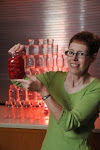Late blight, a highly destructive disease of tomato and potato, has been identified in a home gardener’s tomatoes in Brown County. The infected tomato leaf and fruit sample submitted by the home gardener to the Brown County UW Extension office on August 3rd has been confirmed by Dr. Amanda Gevens, UW-Extension Plant Pathologist, to be late blight infection. This is the first reported case of late blight infection in Brown County. According to the homeowner, the disease spread rapidly in their backyard vegetable garden (within 10 days) and has so far killed 15 tomato plants.
Late blight affects mainly tomatoes and potatoes but it can affect peppers and egg plants to a lesser extent. The cool, wet condition in past few weeks has been ideal for the development of late blight disease and can cause the plant to collapse in about 7-10 days. Other counties in the state that have confirmed the presence of tomato late blight this year are Waukesha, Monroe and Kewanee.
Home gardeners need to be vigilant in scouting their tomatoes and potatoes for late blight. The symptom of the disease begins as pale green or olive green blotches on leaves that enlarge to become brown-black, water-soaked and oily in appearance. Dark brown stem lesions are also prominent on the infected plant. On the fruit, sunken or firm golden to chocolate-brown lesions with distinct rings appear. At a later stage, white-gray fuzzy growth can appear on the infected region of the fruit.
For proper diagnosis, bring a sample of your tomato leaves to the Brown County UW Extension Office.
If you’re unfortunate to have the late blight disease in your tomato plants, harvest only the healthy fruit from all your tomato plants as soon as possible. Infected fruits are bitter in taste and should not be used for cooking or canning purposes. Remove the infected plants completely, place them in a black plastic bag, close the bag and let it sit in the sun for a few days to kill the pathogen. Then place the sealed bag of plants on the curb for trash pickup. Do not compost infected plants.
Source: Vijai Pandian, Brown County UW-Extension Horticulture Educator
Thursday, August 12, 2010
Subscribe to:
Post Comments (Atom)





No comments:
Post a Comment